Trees
Sit in the shade this summer.
Why Plant Trees?
Trees add shade, privacy, colour, and value to your property. However, there are more benefits from trees. They absorb carbon dioxide and potentially harmful gasses from the air and release oxygen. Trees also contribute to boosting biodiversity as they become a food source and natural habitat for wildlife like birds, squirrels, bees, etc. Make sure to choose trees with a non-invasive root system for smaller city gardens.
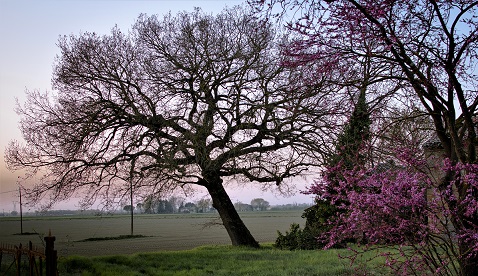
Growing Slowly
Growing and maintaining a tree requires patience. Tree growth is relatively slow in the beginning. After planting your tree out in the ground, the root systems will grow and establish until it is much wider than the tree itself. It is only then, in the second or even thirds year, that your tree will really start to grow much faster.
Plant Your Garden
FIND THE TREES YOU LOVE HERE
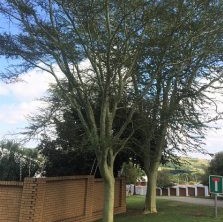
Acacia/Vachellia xanthophloea (Fever Tree)
Attractive, semi-deciduous, tall, fast-growing, distinctive, smooth lime-green branches and stem, bark is slightly flaking, powdery surface
Full sun, Partial shade, Average water to moist, Deep, fertile, sandy soil, 10 – 15 metres tall, Evergreen if watered through winter, Fast growing, Non-aggressive roots, Improves soil fertility by nitrogen fixation
1 m tree K100
1.5 m tree K180
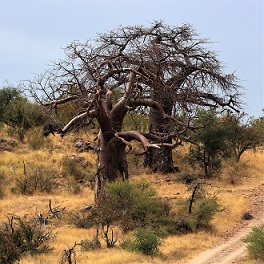
Full sun, well-draining soil, very drought tolerant, water sparingly during winter, largest succulent plant in the world, 15 to 20 m tall
1 m tree K150
1.5 m tree K300
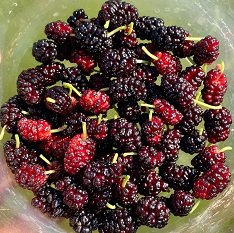
Black Mulberry tree
Very easy to grow, fruit is very nutritious with many medicinal properties and can be eaten fresh out of hand or to make jams, pies, tarts, puddings, Silvopasture, Leaves are highly palatable and digestible, an excellent protein-rich fodder for livestock and can be used as supplements replacing concentrates for dairy cattle, it increase milk production of lactating goats, cows, sheep and rabbits, and improve livestock productivity.
Full sun, will thrive in degraded soils but prefers compost-rich, well-drained soil, very drought tolerant, fast growing, resistant to all major pest and diseases.
1 m tree K100
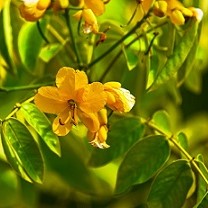
Full sun, Average water, drought tolerant, Any soil,8 to 10 m high, Deciduous, Average to fast growing speed, Root system is not aggressive
1.5 m tree K180
2 m tree K320
2.5 m tree K550
3 m tree K900
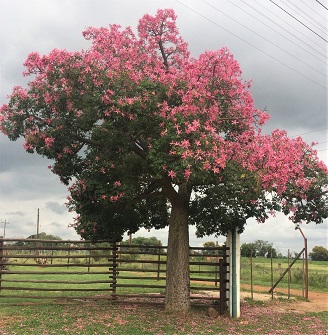
Ceiba speciosa (Pink Kapok Tree)
Full sun, any well-drained soil, average water, moderately drought resistant once well-established, needs lots of space to spread, both above ground and below ground, large root system, not suitable to plant close to sidewalks and foundations, can grow 16 m tall
1.5 m tree K180
2 m tree K320
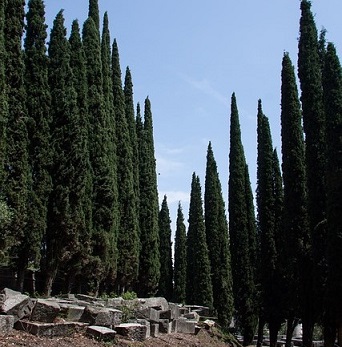
Cupressus sempervirens (Italian cypress)
Extremely popular evergreen tree, of the top trees to increase your property value, tall and narrow, perfect for tight spaces, used for framing, as a strong accent around large buildings, frame the entrance of homes or driveways, line a long driveway, privacy screen between properties, long-lived
Full sun, well-drained soil, average to low water needs, moderately drought resistant, can be planted close to your home as they are unlikely to cause foundation problems, grows 15 m tall
50 cm to 99 cm tree K250
1 m to 1.49 m tree K380
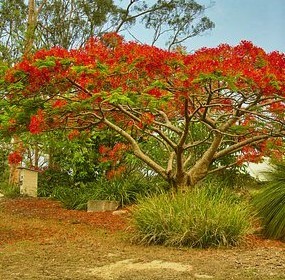
Delonix regia (Flamboyant Tree)
Semi-deciduous or evergreen if watered through dry season, Striking red flowers in spring, wide spreading crown provides dappled shade
Full sun, Average water, drought tolerant, Any soil, 6 – 9 metres tall, Semi-deciduous, Fast growing, Extensive and far-reaching root system
1 m tree K100
1.5 m tree K180
2 m tree K320
2.5 m tree K550
3 m tree K900
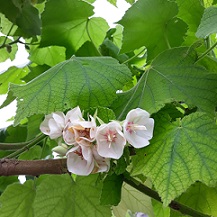
Full sun, deep loose compost-rich soil, water adequately for the first 2 years, it is not related to pear trees but the flowers resemble pear blossoms, non-aggressive root system
1 m tree K100
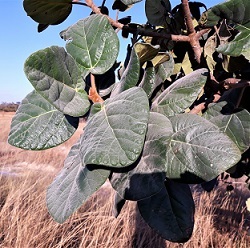
Ficus abutilifolia (Large leaf fig)
Full sun, Average water, drought tolerant, Any soil, 10 – 15 metres tall, Deciduous, Fast growing, Extensive root system, Attracts large number of birds during fruiting season, Vigorous and aggressive root system, National monument in Kabwe
1 m tree K100
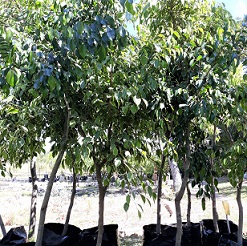
Full sun, tolerant of low light conditions, Average water, Any loose soil, 20 – 30 metres tall, Evergreen, Fast growing, Vigorous and aggressive root system
1 m tree K100
1.5 m tree K180
2 m tree K320
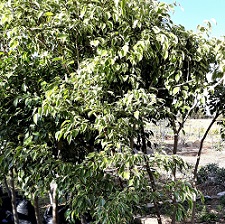
Ficus benjamina Variegata (Variegated Weeping Fig)
Full sun, tolerant of low light conditions, Average water, Any loose soil, 20 – 30 metres tall, Evergreen, Fast growing, Vigorous and aggressive root system
1 m tree K100
1.5 m tree K180
2 m tree K320
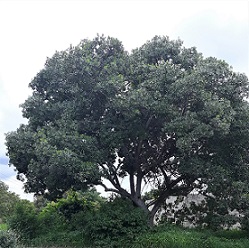
Ficus burkei (Strangler Fig)
Full sun to shade, Average water, drought tolerant, keep moist while young, Any soil, 15 to 18 m tall, Evergreen in wetter habitats, briefly deciduous in drier climates, Fast growing, Massive root system, not suitable as a street tree or near buildings, The strangler fig is not a parasite
1.5 m tree K180
2 m tree K320
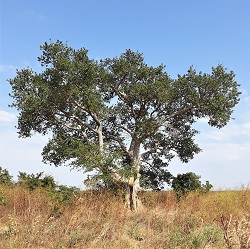
Ficus sycomorus (Sycamore Fig/Mukuyu Tree)
Beautiful yellow-green bark, Fruit attracts a host of birds species, Wild animals and livestock eat the fruits and leaves, Very useful tree, improves infiltration rate and water-holding capacity of the soil
Full sun, Average water, drought tolerant, Any soil, 15 to 20 metres tall, Deciduous, Fast growing, Massive root system, not suitable as a street tree or near buildings
1 m tree K100
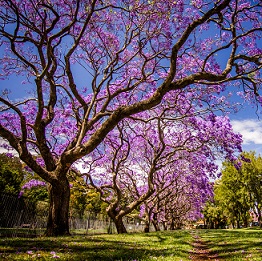
Jacaranda mimosifolia (Jacaranda Tree)
Full sun, Average water, drought tolerant, Any soil, 10 – 15 metres tall, Deciduous, Fast growing, Extensive root system
1.5 m tree K180
2 m tree K320
2.5 m tree K550
3 m tree K900
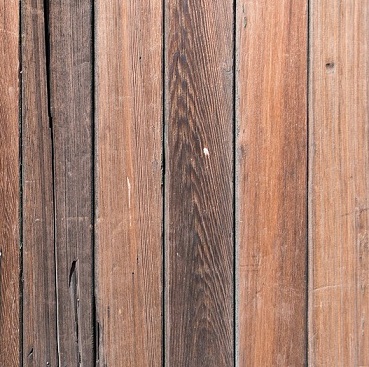
Suitable to grow in most soil types, also tolerant of swampy soils. The wood weathers well and is resistant to borers and termites.
1 m tree K100
1.5 m tree K180
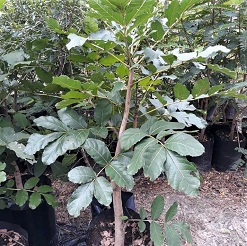
Full sun, any well-draining soil, moderate watering, 10 to 18 m tall, deciduous, choose plant position with care as falling fruit can severely damage anything underneath it
1.5 m tree K180
2 m tree K320
2.5 m tree K550
3 m tree K900
Calistemon viminalis (Weeping bottlebrush)

Full sun, average water, drought tolerant, prefers compost-rich, well-draining soil, but can adapt to various soil conditions, heat tolerant, resistant to most diseases and pests, requiring little maintenance, may be lightly pruned in late winter to keep in shape, usually grows 4 to 6 m tall
1 m tree K100
1.5 m tree was K180
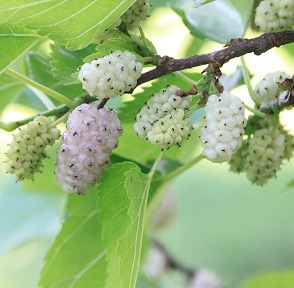
White Mulberry tree
Very easy to grow, fruit is very nutritious with many medicinal properties and can be eaten fresh out of hand or to make jams, pies, tarts, puddings, Silvopasture, Leaves are highly palatable and digestible, an excellent protein-rich fodder for livestock and can be used as supplements replacing concentrates for dairy cattle, it increase milk production of lactating goats, cows, sheep and rabbits, and improve livestock productivity.
Full sun, will thrive in degraded soils but prefers compost-rich, well-drained soil, very drought tolerant, fast growing, resistant to all major pest and diseases.
1 m tree K100

Ochroma pyramidale (Balsa Tree)
Balsa is a pioneer species that thrives on abandoned land, recommended for the recovery of degraded areas and soil improvements. Fast leaf turnover increases the soil organic matter content. The flowers provide abundant food for bats, birds and several insects. The seed fibre is used as stuffing for mattresses and cushions. In aeronautic modelling, Balsa Wood is very much in demand as it is a perfect wood that can easily withstand crash landings and does not cause any major damage. Valued as a component of full-sized light wooden airplanes.
1 m tree K100
1.5 m tree K180
2 m tree K320
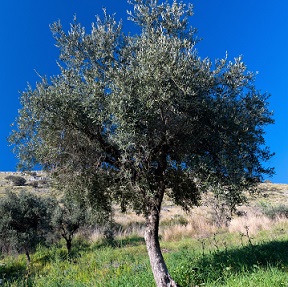
Olea europaea ssp africana (African olive)
Full sun, Average water, drought tolerant, Any soil, 8 to 10 m high, Evergreen, Average growing speed, Roots are only slightly aggressive
1 m tree K100
1.5 m tree K180
2 m tree K320
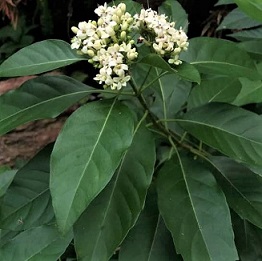
Full sun to Partial shade, Average water, drought tolerant, Any rich, well-drained soil, 6 to 8 m high, Semi-deciduous, Fast growing, Non-invasive roots, Flowers attract butterflies and bees, Berries are eaten by numerous bird species, and game and livestock consume the leaves.
1 m tree K100
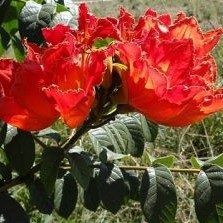
Full sun, Average water, Rich well-drained soil, 15 to 20 m high, Evergreen if watered through winter, Fast growing, Potentially destructive roots, plant some distance away from buildings
1.5 m tree K180
2 m tree K320
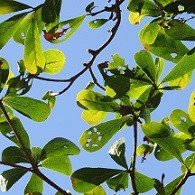
Full sun, Average water, drought tolerant, Well-drained, medium to light soil, 10 m tall, Evergreen if watered through winter and dry season, Average to fast growing, Non invasive root system
1 m tree K100
1.5 m tree K180
2 m tree K320
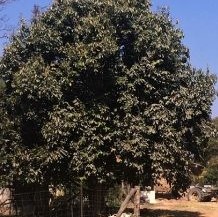
Full sun to Partial shade, Average water, Compost-rich, well-drained soil, 20 to 25 m tall, Evergreen, Moderate growing speed, Non-invasive roots, Popular wood for woodcarving in eastern and southern Africa
1.5 m tree K180
2 m tree K320
2.5 m tree K550
